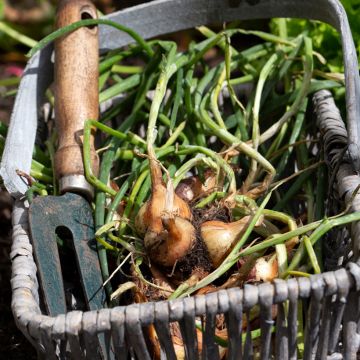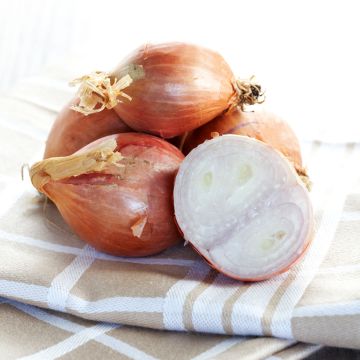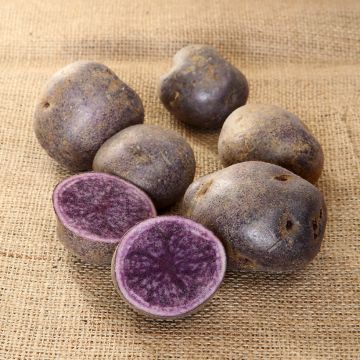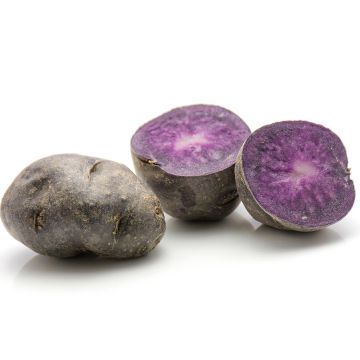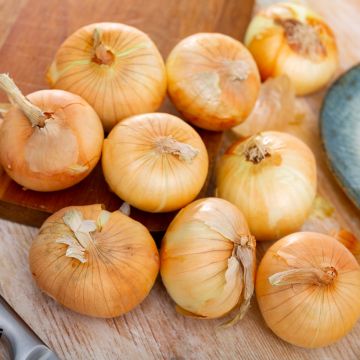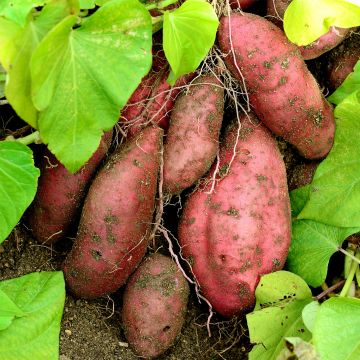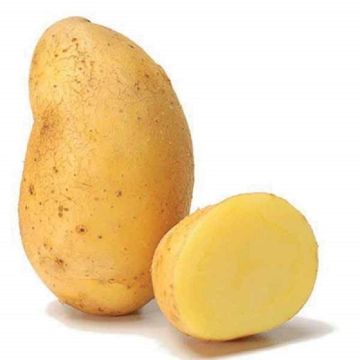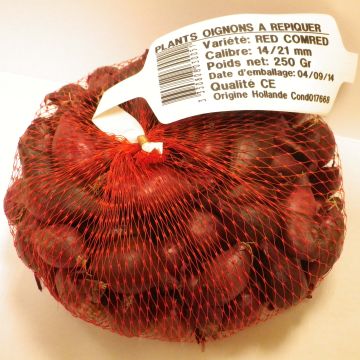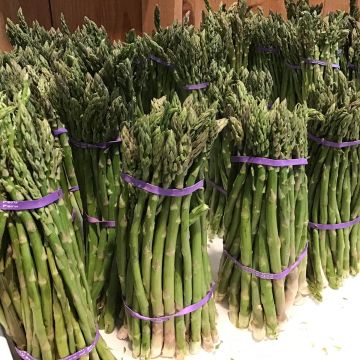

Longor Shallot plants - Allium cepa
Longor Shallot plants - Allium cepa
Allium cepa Longor
Onion, Common onion, Garden onion
Very beautiful bulbs, good yield last year
Michel, 15/02/2022
Special offer!
Receive a €20 voucher for any order over €90 (excluding delivery costs, credit notes, and plastic-free options)!
1- Add your favorite plants to your cart.
2- Once you have reached €90, confirm your order (you can even choose the delivery date!).
3- As soon as your order is shipped, you will receive an email containing your voucher code, valid for 3 months (90 days).
Your voucher is unique and can only be used once, for any order with a minimum value of €20, excluding delivery costs.
Can be combined with other current offers, non-divisible and non-refundable.
Home or relay delivery (depending on size and destination)
Schedule delivery date,
and select date in basket
This plant carries a 6 months recovery warranty
More information
We guarantee the quality of our plants for a full growing cycle, and will replace at our expense any plant that fails to recover under normal climatic and planting conditions.

Description
The 'Longor' shallot is a variety of long pink shallots with a coppery skin. It is early and productive. The pinkish purple flesh is highly aromatic. This variety is well suited for long-term storage. The bulbs are well-formed. Plant the pink shallots from February to April (or in autumn for mild climates) and harvest in July-August.
The shallot, like garlic and onion, belongs to the Liliaceae family. This herbaceous plant produces a cluster of small bulbs topped with narrow, tubular stems. Its delicate flavour is appreciated in cooking. It can be consumed raw, finely chopped to flavor salads and raw vegetables. Cooked, it adds fragrance to stews, sauces, and can also be enjoyed candied. Shallots are rich in vitamins B, C, E, and minerals such as magnesium, iron, and selenium.
There are mainly 2 categories of shallots: pink and grey.
Pink shallots are the most common and include round, long, and semi-long varieties.
Grey shallots have a long and arched bulb; they are more aromatic but have a shorter shelf life.
Harvesting: Shallots are harvested in summer when the foliage starts to turn yellow. Harvesting can start from June for grey shallots and from July for pink shallots. Lift the bulbs and let them dry for 2 or 3 days on the ground in the sun. The foliage can also be harvested when it is green, in spring, as soon as the bulb is formed.
Storage: Cut the stems 1cm (0in) above the collar or, if the condition of the stems allows, braid them for hanging. Check that the bulbs do not have any bruises to prevent rotting that could contaminate the entire harvest. Store them in a dry, cool, and well-ventilated place. Grey shallots can be stored for 6 to 7 months, and pink shallots for 10 to 12 months.
Gardener's tip: Shallots appreciate the company of strawberries, carrots, and lettuce.
Report an error about the product description
Harvest
Plant habit
Foliage
Other Shallots
View all →Planting and care
Shallots thrive in a light, rich, and well-drained soil. They are susceptible to excess moisture, which can cause the bulbs to rot. It is advisable to plant them on mounds to promote water drainage. Similarly, to prevent bulb rot, the soil should not have received any fertilizer for at least one year. Grey shallots are planted in October-November, while pink shallots are planted in spring, from February to April. In regions with mild winters, you can also plant pink shallots in autumn, in October-November.
Loosen the soil. Space the rows 25cm (10in) apart. Build up the soil along the entire row to form a 10cm (4in) high mound. Flatten the top. Plant the bulbs in a staggered pattern, every 20cm (8in), with the pointed end facing upwards, by gently pressing them into the soil. Cover lightly with fine soil, making sure the tip is level with the ground. Watering is not necessary.
Regularly hoe the soil during the month following planting.
Cultivation
Care
Intended location
-
, onOrder confirmed
Reply from on Promesse de fleurs
Similar products
Haven't found what you were looking for?
Hardiness is the lowest winter temperature a plant can endure without suffering serious damage or even dying. However, hardiness is affected by location (a sheltered area, such as a patio), protection (winter cover) and soil type (hardiness is improved by well-drained soil).

Photo Sharing Terms & Conditions
In order to encourage gardeners to interact and share their experiences, Promesse de fleurs offers various media enabling content to be uploaded onto its Site - in particular via the ‘Photo sharing’ module.
The User agrees to refrain from:
- Posting any content that is illegal, prejudicial, insulting, racist, inciteful to hatred, revisionist, contrary to public decency, that infringes on privacy or on the privacy rights of third parties, in particular the publicity rights of persons and goods, intellectual property rights, or the right to privacy.
- Submitting content on behalf of a third party;
- Impersonate the identity of a third party and/or publish any personal information about a third party;
In general, the User undertakes to refrain from any unethical behaviour.
All Content (in particular text, comments, files, images, photos, videos, creative works, etc.), which may be subject to property or intellectual property rights, image or other private rights, shall remain the property of the User, subject to the limited rights granted by the terms of the licence granted by Promesse de fleurs as stated below. Users are at liberty to publish or not to publish such Content on the Site, notably via the ‘Photo Sharing’ facility, and accept that this Content shall be made public and freely accessible, notably on the Internet.
Users further acknowledge, undertake to have ,and guarantee that they hold all necessary rights and permissions to publish such material on the Site, in particular with regard to the legislation in force pertaining to any privacy, property, intellectual property, image, or contractual rights, or rights of any other nature. By publishing such Content on the Site, Users acknowledge accepting full liability as publishers of the Content within the meaning of the law, and grant Promesse de fleurs, free of charge, an inclusive, worldwide licence for the said Content for the entire duration of its publication, including all reproduction, representation, up/downloading, displaying, performing, transmission, and storage rights.
Users also grant permission for their name to be linked to the Content and accept that this link may not always be made available.
By engaging in posting material, Users consent to their Content becoming automatically accessible on the Internet, in particular on other sites and/or blogs and/or web pages of the Promesse de fleurs site, including in particular social pages and the Promesse de fleurs catalogue.
Users may secure the removal of entrusted content free of charge by issuing a simple request via our contact form.
The flowering period indicated on our website applies to countries and regions located in USDA zone 8 (France, the United Kingdom, Ireland, the Netherlands, etc.)
It will vary according to where you live:
- In zones 9 to 10 (Italy, Spain, Greece, etc.), flowering will occur about 2 to 4 weeks earlier.
- In zones 6 to 7 (Germany, Poland, Slovenia, and lower mountainous regions), flowering will be delayed by 2 to 3 weeks.
- In zone 5 (Central Europe, Scandinavia), blooming will be delayed by 3 to 5 weeks.
In temperate climates, pruning of spring-flowering shrubs (forsythia, spireas, etc.) should be done just after flowering.
Pruning of summer-flowering shrubs (Indian Lilac, Perovskia, etc.) can be done in winter or spring.
In cold regions as well as with frost-sensitive plants, avoid pruning too early when severe frosts may still occur.
The planting period indicated on our website applies to countries and regions located in USDA zone 8 (France, United Kingdom, Ireland, Netherlands).
It will vary according to where you live:
- In Mediterranean zones (Marseille, Madrid, Milan, etc.), autumn and winter are the best planting periods.
- In continental zones (Strasbourg, Munich, Vienna, etc.), delay planting by 2 to 3 weeks in spring and bring it forward by 2 to 4 weeks in autumn.
- In mountainous regions (the Alps, Pyrenees, Carpathians, etc.), it is best to plant in late spring (May-June) or late summer (August-September).
The harvesting period indicated on our website applies to countries and regions in USDA zone 8 (France, England, Ireland, the Netherlands).
In colder areas (Scandinavia, Poland, Austria...) fruit and vegetable harvests are likely to be delayed by 3-4 weeks.
In warmer areas (Italy, Spain, Greece, etc.), harvesting will probably take place earlier, depending on weather conditions.
The sowing periods indicated on our website apply to countries and regions within USDA Zone 8 (France, UK, Ireland, Netherlands).
In colder areas (Scandinavia, Poland, Austria...), delay any outdoor sowing by 3-4 weeks, or sow under glass.
In warmer climes (Italy, Spain, Greece, etc.), bring outdoor sowing forward by a few weeks.






























